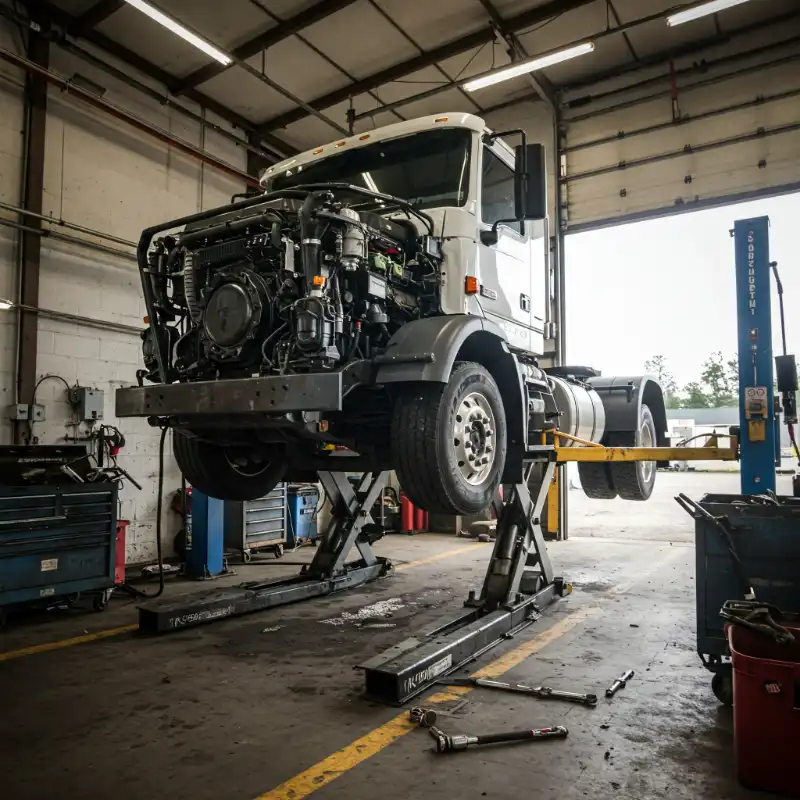The Impact of Freezing Temperatures on Transmissions
Diesel truck transmissions undergo challenges when confronted with freezing temperatures. The impact of extreme cold extends to various components, demanding an understanding for effective maintenance. It's important to be equipped with insights into lubricants, fluids, freezing points, and viscosity changes to navigate winter conditions seamlessly.
Lubricants and Fluid Dynamics
In sub-zero temperatures, lubricants within the transmission face a significant transformation. The cold can cause the fluid to thicken, leading to increased viscosity. This heightened viscosity poses challenges for fluid circulation and can result in sluggish shifting and poor gear engagement. Therefore, choosing the right transmission fluid with a suitable viscosity index for colder climates becomes paramount.
Potential Freezing Points
Understanding the freezing points of transmission fluids is crucial. As temperatures drop, fluids can freeze, impeding their ability to lubricate and causing potential damage to the transmission system. Fleet managers should ensure that the chosen fluids have low pour points to maintain functionality even in extreme cold.
Challenges Faced by Drivers and Mechanics
Truck operators and mechanics grapple with challenges during the winter months. The cold weather not only affects the mechanical aspects of the transmission but also impacts the overall performance of the vehicle. Drivers often encounter difficulties with gear changes, leading to increased wear and tear on transmission components. Mechanics, on the other hand, face the added complexity of working in freezing conditions, necessitating special precautions and equipment.
Common Cold-Weather Transmission Problems
Diesel truck transmissions in freezing temperatures often exhibit specific problems that demand prompt attention and diagnostic precision.
Sluggish Shifting and Gear Engagement Issues
One common issue in cold weather is sluggish shifting. The transmission may hesitate or struggle to change gears smoothly, affecting the vehicle's overall performance. Difficulty in engaging gears is another prevalent problem, resulting in a less responsive and reliable transmission system.
Transmission Fluid Issues
Cold temperatures can lead to transmission fluid-related problems. Fluids may become more viscous, hindering proper circulation. Additionally, moisture can accumulate within the transmission system, causing fluid contamination and potential damage. Identifying these issues promptly is essential for preventing further transmission damage.
Diagnostic Techniques and Tools
Accurate diagnosis is the cornerstone of effective transmission repairs. Utilizing advanced diagnostic tools designed for cold weather conditions is imperative. These tools can assess the transmission's performance, identify potential issues, and provide insights into the overall health of the system. Regular transmission fluid analysis, along with temperature and pressure monitoring, can help preemptively address problems before they escalate.
Strategies for Transmission Repairs in Freezing Conditions
Beyond diagnosis, implementing practical strategies for repairing diesel truck transmissions in freezing conditions is crucial for maintaining optimal performance throughout the winter.
Preventive Maintenance Tips
- Regular Fluid Checks: Schedule frequent fluid checks to monitor viscosity levels and identify potential issues before they have the chance to escalate. By incorporating a routine fluid inspection into your maintenance schedule, you can proactively address challenges and ensure the performance of your transmission system, even in freezing temperatures.
- Use of Winter-Grade Fluids: Switching to winter-grade transmission fluids with lower pour points is a proactive step to guarantee fluidity in cold temperatures. These specialized fluids are formulated to withstand freezing conditions, maintaining the necessary flow characteristics that are crucial for a well-functioning transmission. By making this adjustment, you fortify your diesel truck against the adverse effects of cold weather.
- Heating Systems: As an integral part of your preventive maintenance, consider the installation of transmission heating systems. These systems maintain fluids at optimal operating temperatures, mitigating viscosity-related problems in freezing conditions. By incorporating heating systems into your fleet, you provide an additional layer of protection for your transmission, ensuring its reliability even in the harshest winter climates.
To learn more about our preventive maintenance services, click here!
Safety Measures
Extreme cold introduces additional challenges to the already complex task of transmission repairs. Implementing comprehensive safety measures is imperative to protect mechanics working in freezing conditions. This includes the use of anti-slip materials to minimize the risk of accidents, providing insulated gear to combat the cold, and ensuring that mechanics have adequate personal protective equipment. These safety measures not only prioritize the well-being of your team but also contribute to the seamless execution of transmission repairs, fostering a secure and productive working environment in the face of freezing temperatures.
Step-by-Step Guide for Common Transmission Repairs
- Fluid Replacement: Follow manufacturer recommendations for fluid replacement intervals, ensuring the use of suitable winter-grade fluids.
- Seal Inspections: Regularly inspect seals for wear and damage, as cold weather can exacerbate seal deterioration.
- Gear Synchronization: Address issues related to gear synchronization by adjusting or replacing components as needed.
- Torque Converter Checks: Examine the torque converter for any abnormalities, as cold weather can impact its performance.
Recap
Diesel truck transmissions demand meticulous attention in freezing temperatures. Understanding the impact of cold weather on lubricants, fluid dynamics, and overall system performance is crucial for effective maintenance. Identifying common cold-weather transmission problems, employing advanced diagnostic techniques, and implementing practical repair strategies are key elements in ensuring smooth operations during the winter months.










.webp)





























